 Karee, Rooikaree, iNhlangutshane (Searsia lancea)There are some core reasons why you should plant fire retardant trees and shrubs around the perimeter or high resistance zone of your property to make your home safer if a wildfire sweeps through.
Karee, Rooikaree, iNhlangutshane (Searsia lancea)There are some core reasons why you should plant fire retardant trees and shrubs around the perimeter or high resistance zone of your property to make your home safer if a wildfire sweeps through.
A windbreak of trees gives protection for a distance of roughly twenty five times the height of the trees, and trees have the added benefit of slowing the wind and catching embers. Fire retardant trees are also a physical barrier to the heat blast coming through, acting as a green shield in front of your home, and some trees will actually stop the fire from moving through because the amount of moisture in the leaf tissue of the plant is enough to stop the fire.
For example, a row of our indigenous Milkwood trees (Sideroxylon inerme) with their thick, leathery, evergreen leaves, and dense, low crown, can stop a fire dead in its tracks, and people with homes situated on mountains where fires frequently occur, are recommended to plant a row as both a wind and firebreak in the buffer zone.
Thankfully there are many Indigenous and exotic plants that can be used to firescape your garden, and the plants you select will be determined by the region you live in - its climate, rainfall, and soil type. Visit your local garden centre before finalising your plant list to ensure that the plants selected are suitable for your growing region.
A question most often asked is “are palm trees fire resistant?” Click here to find the answer in my free article. /are-palm-trees-fire-resistant
Although a lot of research has been done on the fire resistance of many garden plants, the science of firescaping is still in its infancy and a lot of studies still need to be done on this subject. There are thousands of fire resistant plant lists available online, some of which are compiled simply by observing which garden plants have survived fierce wildfires, and which seemed to fuel the fires.
The plant list below is by no means complete and was compiled from information available in South Africa, and worldwide, but especially those fire prone regions of Australia and California, as they grow many of the same garden plants as we do in South Africa.
The purpose of this document is to provide homeowners with guidance on ways to landscape their property with fire resistant plants to help reduce losses from wildfire damage. It contains suggestions and recommendations, and is intended to serve only as a guide. If you live in a high fire zone it is recommended that you do your own research and seek advice from garden centres and locals in your area before making your final plant selection.
The plants listed below are both exotic and indigenous to South Africa, and they include plants for all the zones of a firescaped garden.

Cheesewood (Pittosporum viridiflorum)
The cheesewood is listed for firescaping and is often described as “the perfect garden tree” because it is versatile and can be allowed to grow naturally into a beautiful low maintenance, well-shaped, medium-sized tree. It can be clipped into a hedge or screening plant, and grows well in large pots. It grows moderately and has non-invasive roots, making it safe alongside paving, and its lovely shiny, evergreen foliage does not make a mess.
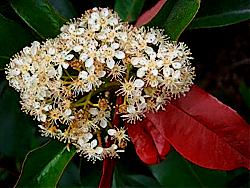
Red Robin (Photinea x fraseri)
'Red Robin' is recommended as a fire retardant plant in Australia. It makes a fantastic hedging plant that can be pruned to form large formal hedges, or informal screens. By pruning out the lower branches individual shrubs can be trained into small trees. If you clip it lightly as soon as the red colour in the young growth begins to fade in spring, and continue to do so, the plant will continually produce new red growth, adding considerable interest to the garden with its contrasting foliage.

Sweet Viburnum (Viburnum)
The cool temperate species of Viburnums are deciduous, while most of the warm temperate species are evergreen, and it’s the evergreens, and especially Viburnum tinus, Viburnum tinus 'Variegatum', and the dwarf Viburnum tinus 'Compacta', that are recommended for firescaping gardens, as the leaves are covered with a waxy outer layer to retain moisture in the dry summer months. Evergreen viburnums respond well to pruning, and can be clipped into any shape, making them ideal for formal or informal hedges and screens. Sterile cultivars of Viburnum tinus are not invasive.

Camellias
There are countless hybrids derived from three particularly attractive Camellia species, the autumn flowering Camellia sasanqua, the winter-flowering Camellia japonica, and the large-flowered Camellia reticulata that finishes blooming in spring. Because of their thick moist leaves, camellias act as a good fire protection barrier, and despite their adversity to drought and intense heat, the plants will generally re-sprout after being burnt in a fire. The taller varieties are often trimmed up as small trees or trained as standards, and shrubby cultivars are used as formal hedging plants, or informal screens.
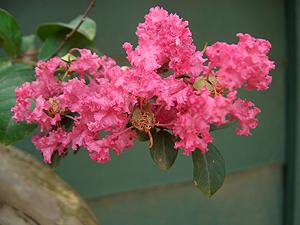
Pride of India (Lagerstroemia indica)
This little deciduous tree is listed for firescaping. It is multi-stemmed and forms a spreading, flat topped crown. A number of varieties have been bred, from tidy street trees or dense barrier hedges, to fast-growing dwarf types which only grow about 60cm tall. Because of its good drought-tolerance and its ability to grows well in spaces with limited soil, it's recommended for planting in urban and suburban areas along boulevards, in parking lots, and in small pavement cut-outs, or where compacted soil is common.

Cross-berry, Mokukutu (Grewia occidentalis)
The cross-berry is listed on many sites as fire resistant, and this branching, woody shrub or small tree is widely spread in South Africa, and can be found growing in all the provinces. The plant varies greatly in height and spread, according to the climate of the region in which it is grown. It can reach anything from 2 to 6m tall and is normally well-branched. It does not have an aggressive root system, and makes a good informal hedging or screening plant, is beautiful in the mixed shrub border, and also grows easily in containers.

Tree Fuchsia, Witolyf (Halleria lucida)
Evergreen forest trees like Halleria do not burn easily and are used as a fire retardant in the buffer zone, and the medium resistant zone. It does not have invasive roots, grows quickly, and makes a good specimen tree for the smaller garden. In large gardens and parks it looks lovely planted in groups. It's also an excellent informal screening plant or hedge and grows beautifully in large containers. In dry regions it remains a shrubby tree but in moist positions it can grow 10 to 20m.

Cape Holly, iPhuphuma (Ilex mitis)
The Cape holly is recommended for firescaping and is a truly beautiful medium-sized evergreen tree. In cultivation it is relatively fast growing, and usually remains a small to medium-sized tree that seldom grows taller than 8m, with a gracefully rounded crown of glossy, dark green leaves. It does not have an invasive root system, making it an ideal shade tree, and because it can be clipped into almost any shape, it makes an excellent hedge or windbreak. And, although it loves moisture, it will also tolerate long periods of drought.

Camphorbush, Wildekanferbos, (Tarchonanthus camphoratus)
This plant grows wild in all our provinces, varying greatly in height from 2 to 9m. It is as tough as nails and a most effective pioneer species to create shade and shelter for slower growing plants. It is also fire resistant and makes a good fire break, because it will slow down a fire, and is able to re-sprout after a fire; and its fibrous root system makes it an excellent choice to control soil erosion. Therefore the camphorbush is recommended for the buffer zone on the perimeter of a firescaped property, if a tall hedge or large windbreak is needed.

White Milkwood, Witmelkhout, aMasethole (Sideroxylon inerme)
A row of milkwood trees with their thick, leathery, evergreen leaves, and dense, low crown, can stop a fire dead in its tracks, and people with homes situated on mountains where fires frequently occur, are recommended to plant a row as both a wind and firebreak in the buffer zone. Due to its densely spreading foliage, it is a superb shade tree, and to appreciate it fully, plant it as a single specimen in a large lawn, or even in a large container on the patio. This semi-coastal tree and should be planted where a windbreak offers it some protection from salty winds.
Members can click here to read more about the White Milkwood

Karee, Rooikaree, iNhlangutshane (Searsia lancea)
Searsia lancea is an evergreen shade tree that is listed as being fire resistant, and I assume that our other karee trees like; Searsia chirindensis; Searsia lucida; and Searsia pendulina would have the same attributes. All of them are hardy park or street trees that can be planted underneath powerlines, in lawns, and near paving and tarred surfaces. Because of their dense growth habit they make a most effective windbreak and informal hedge or barrier for large properties and farms. They are also useful soil stabilisers, and increase the soil penetration of rainwater, reducing erosion and raising the ground water table.
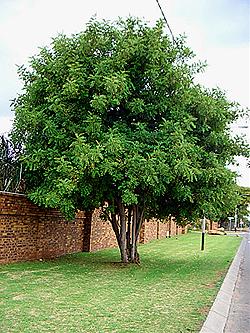
Carob Tree (Ceratonia siliqua)
The carob tree is a most effective fire barrier as its leaves burn very poorly, and it's highly recommended for fire-wise landscaping. In its natural habitat it grows as a large evergreen shrub which may mature into a magnificent tree. It’s hard and leathery foliage is specially adapted to prevent moisture loss, and although classified as evergreen, every second year in spring it will partially drop leaves, replacing them immediately with new ones. It remains a popular ornamental shade tree for farms, large parks and gardens, and although the branches can break in high winds and storms, the trees remain useful for windbreaks.

Coral Tree (Erythrina species)
Our magnificent coral trees are recommended for firescaping. The Dwarf Coral Tree (Erythrina humeana) produces a number of stems from the ground 1.5 to 4m high, and is suitable for small gardens and pots. The Common Coral Tree (Erythrina lysistemon) often branches low down on the trunk. In arid regions it will remain small, reaching about 5m tall with an equal spread; while in moister regions it may reach 6 to 8m in height and spread. The Broad-leaved Coral Tree, (Erythrina latissima) is a medium-sized to large tree which develops several rounded heads to form a wide, spreading canopy. It can reach 9 to 12m tall, with a spread of 7 to 11m.
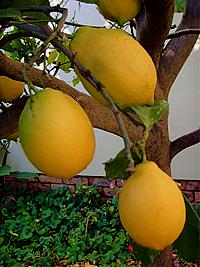
Citrus species
Many fruit trees are inherently fire safe, as they actively grow in summer, have thin, moist leaves that will wilt instead of burn, and are pruned annually to remove any dead material. In regions prone to fires, crews of firefighters are trained to use orchards as natural firebreaks, and they often shelter among the rows of irrigated trees to escape runaway flames. Apples pears and citrus can be fire safe, provided the trees are spaced openly, and are planted at least 5m from any buildings. Citrus can make the perfect evergreen garden tree, and even the smallest of gardens can have one because they also grow beautifully in pots.
 image placeholder
image placeholder Olive (Olea europaea)
While many trees are vulnerable to fire, olive trees have some natural fire resistance. Their thick, leathery leaves are difficult to ignite and their low, spreading branches make it hard for fire to spread up the trunk. In addition, olive trees have a high water content, which helps to keep them from drying out and becoming more flammable. Olive groves are also are excellent places to put out a fire. The name Olea europaea applies to both the wild and domestic Olive trees, and new fruiting varieties do not grow as large, making them more suited to home gardens and for planting into a large pot.

Large Num-num Amatungulu (Carissa macrocarpa)
The num-num is not only a superb looking shrub; its leathery leaves are also fire resistant, and the reason why it is recommended to plant in regions prone to wildfires. It is a slow starter, but grows quickly after the first season. If left un-pruned it will grow up to 5m tall and about 2m wide, but is usually clipped into a shrub about 2m tall. Plant it in the mixed shrub border or train it into a small tree. The long, sharp thorns it produces are neatly forked, making it a first class impenetrable hedge. To grow a hedge, plant out about 1m apart. It also grows easily in containers.
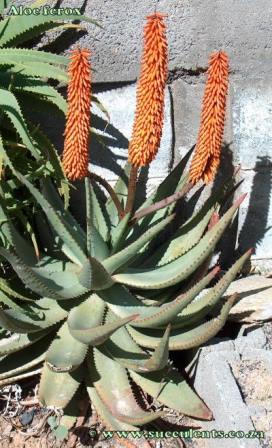
Bitter Aloe, Bitteraalwyn, iNhlaba (Aloe ferox)
Owing to their moisture-retaining leaves that contain no flammable resins or oils, aloes can be used as living firebreaks around the perimeter of your property and in island beds in the garden zone. It is adaptable to many conditions and makes a great architectural and specimen plant for the garden with its tall, single, upright, woody stem; varying in height from 1.8 to 5m in mature specimens. Mature plants carry a skirt of dried leaves, and in the wild this acts as a protection against fire.
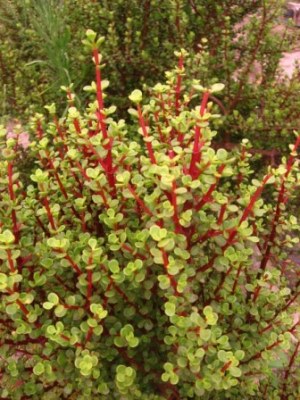
Spekboom, iGqwanitsha (Portulacaria afra)
The spekboom is an attractive evergreen succulent which is excellent for firescaping properties. There are several forms, and the large one can be clipped into a hedge or informal screen, as it will grow to a height of about 1.5 to 2m, but can mature into a small tree 2 to 5m tall, and the dwarf forms are excellent groundcovers for all gardening zones, and especially for the buffer zone. It is also heat and drought tolerant, and a good soil binder, helping to prevent soil erosion.
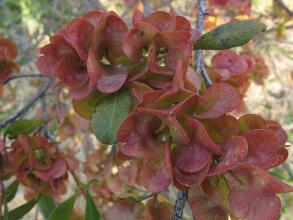
Sand Olive, Sandolien (Dodonaea viscosa angustifolia)
The Commonwealth Scientific and Industrial Research Organisation (CSIRO) tested and listed the ignitability of Australian plants, and they listed Dodonea on List 1 as plants backed by scientific evidence, or overwhelming use as a fire break. It is known for tolerating a wide range of growing conditions, and is one of the first plants to establish itself on disturbed ground. This plant makes a great small to large, multi-stemmed shrub, or specimen tree, even for small gardens, and is often used as an informal screen or hedge.

